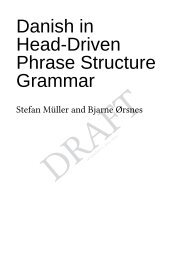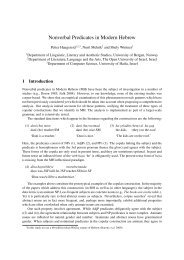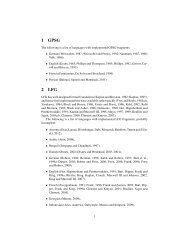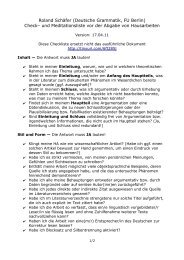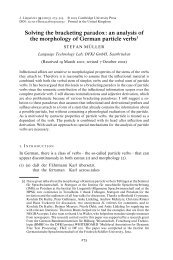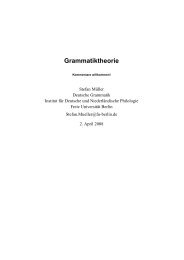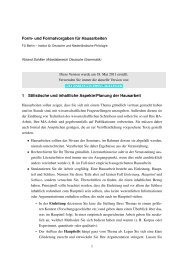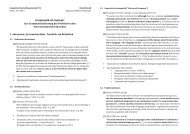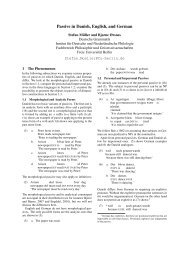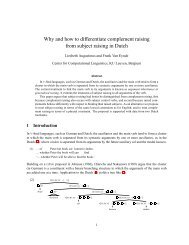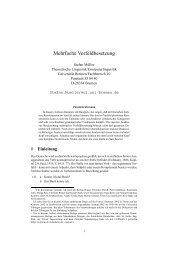1 GPSG 2 LFG - German Grammar Group FU Berlin - Freie ...
1 GPSG 2 LFG - German Grammar Group FU Berlin - Freie ...
1 GPSG 2 LFG - German Grammar Group FU Berlin - Freie ...
You also want an ePaper? Increase the reach of your titles
YUMPU automatically turns print PDFs into web optimized ePapers that Google loves.
• http://www.delph-in.net/erg/<br />
• http://hpsg.fu-berlin.de/Demos/<br />
5 Construction <strong>Grammar</strong><br />
John Bryant, Nancy Chang, Eva Mok developed a system for the implementation of<br />
Embodied Construction <strong>Grammar</strong> 6 . Luc Steels works on the simulation of language<br />
evolution and language acquisition (Steels, 2003). In personal communication (p. M.<br />
2007) he stated that is is a long way to go until robots finally will be able to learn to<br />
speak but the current state of the art is already impressive. Steels can use robots that<br />
have a visual system (camera and image processing) and uses visual information paired<br />
with audio information in the language acquisition simulation. The implementation of<br />
Fluid Construction <strong>Grammar</strong> is documented in Steels, 2011 and Steels, 2012. The<br />
second book contains parts about <strong>German</strong>, in which the implementation of <strong>German</strong><br />
declarative clauses and w interrogative clauses is explained with respect to topological<br />
fields (Micelli, 2012). The FCG system, various publications and example analyses<br />
are available at: http://www.fcg-net.org/. Jurafsky (1996) developed a Construction<br />
<strong>Grammar</strong> for English that was paired with a probabilistic component. He showed that<br />
many preformance phenomena that are discussed in the literature (see Section ?? on<br />
the Competence/Preformance Distinction) can be explained with recourse to probabilities<br />
of phrasal constructions and valency properties of words. Bannard, Lieven<br />
and Tomasello (2009) use a probabilistic context free grammar to model grammatical<br />
knowledge of two and three year old children.<br />
6 TAG<br />
There exist various synstems for the processing of TAG grammars (Doran, Hockey,<br />
Sarkar, Srinivas and Xia, 2000; Parmentier, Kallmeyer, Maier, Lichte and Dellert,<br />
2008; Kallmeyer, Lichte, Maier, Parmentier, Dellert and Evang, 2008). Smaller and<br />
larger TAG fragments have been developed for the following languages:<br />
• Arabic (Fraj, Zribi and Ahmed, 2008),<br />
• <strong>German</strong> (Rambow, 1994; Gerdes, 2002; Kallmeyer and Yoon, 2004; Lichte,<br />
2007),<br />
• Englisch (XTAG Research <strong>Group</strong>, 2001; Frank, 2002; Kroch and Joshi, 1987),<br />
• French (Abeillé, 1988; Candito, 1996, 1998, 1999; Crabbé, 2005),<br />
• Italian (Candito, 1998, 1999),<br />
• Korean (Han, Yoon, Kim and Palmer, 2000; Kallmeyer and Yoon, 2004),<br />
• Vietnamese (Le, Nguyen and Roussanaly, 2008)<br />
6 See http://www.icsi.berkeley.edu/~jbryant/old-analyzer.html and Bryant, 2003.<br />
6




